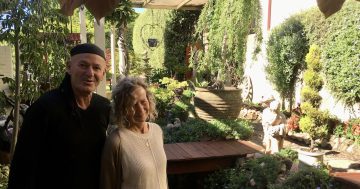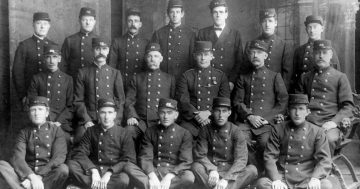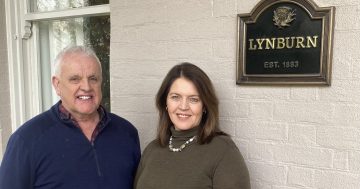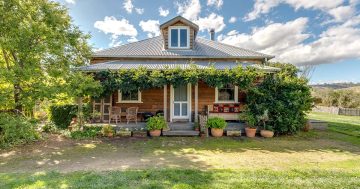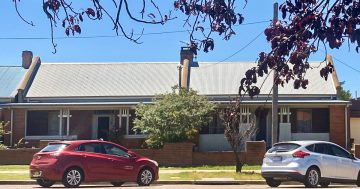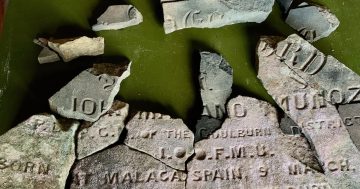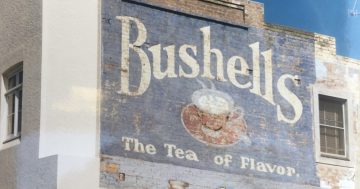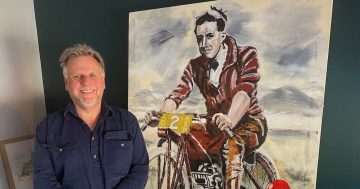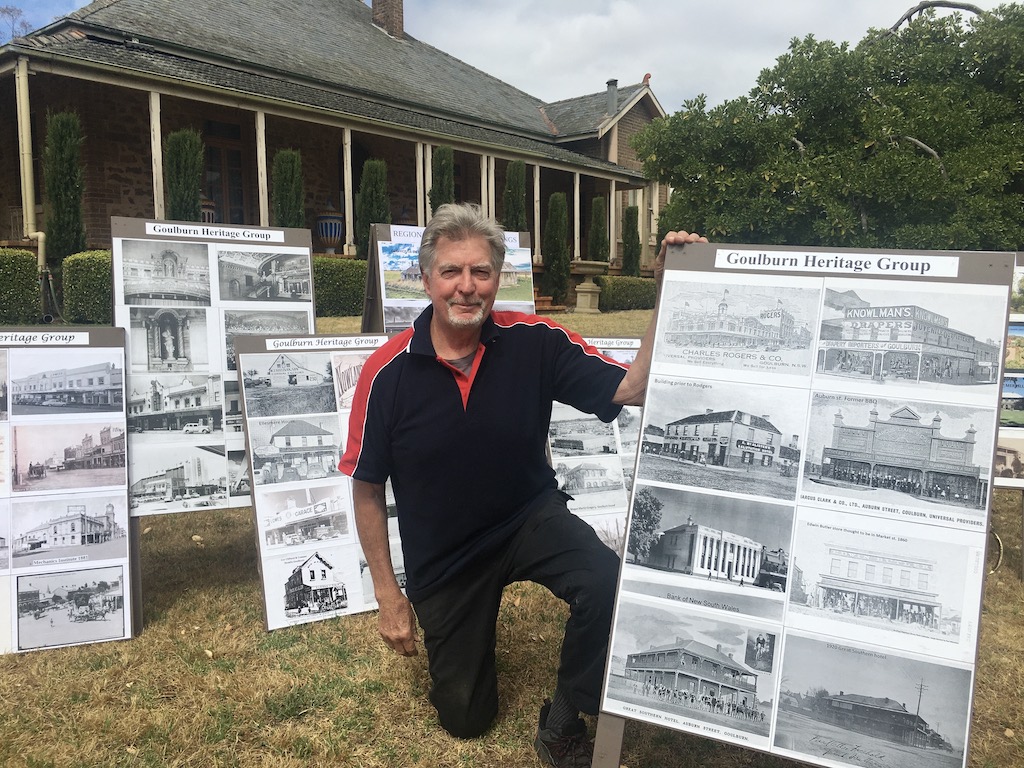
Goulburn Heritage Group volunteer Doug Rawlinson with a collection of images of early commercial buildings in Goulburn. His display boards cover many aspects of the city’s early history. Photo: John Thistleton.
Strewn across the Goulburn region and dotted around the city, magnificent mansions from the wool boom, hotels and palatial picture theatres have been gathered up like gold dust to make a stunning presentation of images.
Lined up side by side, the historic photographs are irresistible, as Doug Rawlinson has found each time he gives people a glimpse of his collection, mounted on A-frame boards.
Having created the display over four months, he aims to highlight the work of the Goulburn Heritage Group. With only five or six active members, these volunteers punch above their weight in output, scrutinising new development applications, needling the city’s administrators at any heritage oversight, advising the city’s planners on heritage matters and advocating for the city’s built heritage.
The trouble is most of their activities go unseen and their pleas for more resources and regard for heritage sometimes go unanswered. Doug decided to stoke up interest by getting the buildings out into the public arena and letting them speak for themselves.
The results have been immediate. A group of visitors to his historic homestead ”Kentgrove” swarmed around the display boards, asking questions.
“Everybody loves heritage, but don’t do much about it. This is what I want to instil in people,” he said, indicating the dozens of historic properties in and around Goulburn.
“We need young people to come into the Goulburn Heritage Group, otherwise one day we will fold.”
Assembling black-and-white images of early streetscapes of Goulburn on A-frames was eye-opening even for himself.
“That’s what really got me enthused,” he said, looking at an 1870 photo of Auburn Street with graceful buildings facing one another, surrounded by bare hills. Looking like a city waiting to happen, the photo was taken a year after the railway line reached Goulburn.
In bygone eras, most of the big sheep stations around Goulburn, such as Springfield and Kippilaw, had numerous permanent employees living in surrounding villages on the properties. One property near Lake Bathurst, formerly known as ”Woolowolar” and ”Redford Park”, later turned into an agricultural college, ”Inveralochy”. Doug’s ”Kentgrove” had a flourishing jam factory with 10 to 15 employees.
Each time he features one of the properties on the Goulburn Heritage Group’s Facebook site, which he launched about three years ago, scores of people react and comment each time, mostly about their involvement or their family’s connection with the property.
In addition to the 1500 followers gathered over three years, 40 more have joined in the past two months due to the interest in historic homes and places.
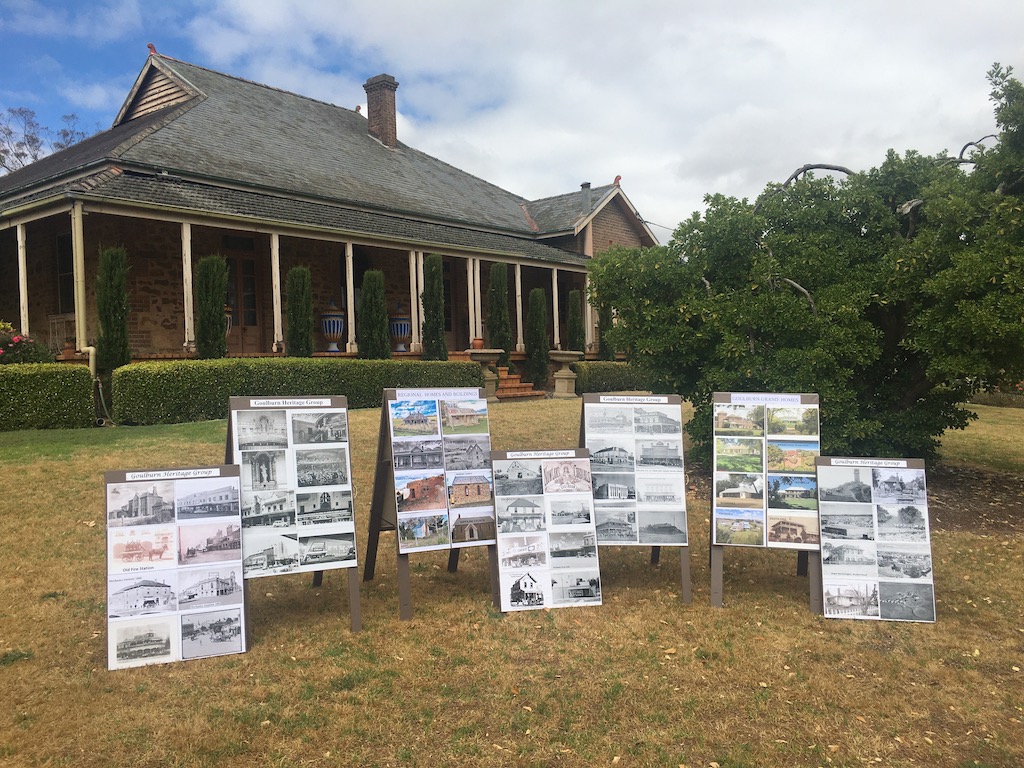
Slab huts, a stone ruin, churches, streetscapes and rural properties all feature on the Goulburn Heritage Group’s display, with historic Kentrove as a backdrop. Photo: John Thistleton.
“I was going to stop at 20 [properties] but expect to get to 30 and then stop,” he said. “Then I will apologise to anyone who didn’t get their home in. People are messaging me with names, history and bits and pieces on houses I didn’t even know existed.”
The works of regular photographers of historic sites, Neville Friend and DTC Photography (David Carmichael), are among the collection. Information is flooding in from people with Goulburn connections, including Allan Hunt, now living in Queensland, who comes from a family at Parkesbourne, and Rod McInnes, now living in Sydney. They are weighing in with local knowledge and links to Trove Library to add to the contributions of local historians.
Allan and Doug have found that both worked on substantial properties with landscaping and gardening in the past, as did relatives of Allan’s, including Reg Hunt.
The collection reveals little-known places including the W J Sullivan and Son cordial factory building, which Doug suspects still stands in North Goulburn behind Hopes Cordials. Long-forgotten places are on the boards, such as ”Goulburn House”, also known as ”Marsden House”, on the north-west corner of Bourke and Clifford streets, before it was demolished.
Many of the grand homes are familiar, while others such as Wollogorang homestead, south of Goulburn, elicited a comment from former owner Graeme Webb, who owned it for 20 years, restored it and replaced the original verandah.
One board is devoted to the main-street picture theatres that were demolished. Past eras captured by the camera include a vast yarding of sheep at the saleyards and an aerial photograph of the former Goulburn Teachers College, now the NSW Police Academy.
Doug’s next step will be to find places where his collection can be publicly displayed, either at a cafe or foyer of the Goulburn Mulwaree Council, library, or perhaps the Visitors Information Centre, or one of the weekend markets.
Original Article published by John Thistleton on About Regional.












